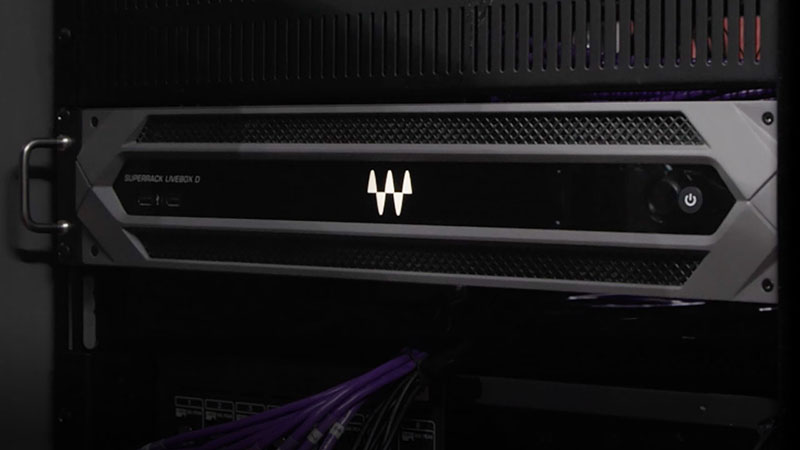Twenty One Pilots Choose Waves SuperRack LiveBox for 2024 World Tour
November 13, 2024

Live mixing engineer Kenny Sellars has been helming front-of-house for Twenty One Pilots for the past few years, ensuring that their adrenaline-fueled shows are as sonically captivating as they are exciting. With an impressive career that has also included work with Doja Cat and Shania Twain, Sellars has been entrusted with Twenty One Pilots’ live sound over several world tours, delivering consistently superb mixes for a show that’s dynamic, diverse, and often unpredictable.
For the band’s 2024 world tour, Sellars needed a reliable solution to elevate the already high standard of their live shows. Enter Waves SuperRack LiveBox, a compact yet powerful unit that Sellars is now integrating into his setup. Having relied on Waves plugins for over 12 years, Sellars knew the quality and precision they offered, but he was excited to discover how the new LiveBox could further enhance his workflow.
“I’ve been using Waves in my live setups for over a decade now,” Sellars explains. “When I heard about SuperRack LiveBox, which allows the use of both Waves and other manufacturers’ VST3 plugins in a stable, native setup, I had to give it a try.” The SuperRack LiveBox Dante® model, which supports up to 128 channels and features ultra-low latency and PSU redundancy, immediately fit the bill for the complex needs of a Twenty One Pilots show. The choice was made easier by the seamless integration LiveBox offered. “Everything on this tour runs through Dante,” Sellars notes, “all operating on a single network. This made it so easy to route any channel directly into the LiveBox, back out, and straight into my console. All the devices started talking to each other instantly. The LiveBox just showed up on the Dante control and I could patch it however I wanted—easy.”
“What’s also helpful,” he adds, “is that the software interface of the LiveBox is the Waves SuperRack Performer, which, as a SuperRack user for years, I’m very familiar with.”
When he first tested the LiveBox, Sellars decided to push the system to its limits. “I thought, let’s stress-test it! I set it to the lowest latency possible and a 32-sample buffer size,” he recalls. “Then I started loading it with reverb plugins that consume the most resources, along with some Waves F6 Dynamic EQs, distortions and other effects. Even with all that, I only hit about 30% of the buffer capacity. I didn’t feel the need to push it any further because I already had everything I needed.”
Using Waves plugins is an integral part of Sellars’ workflow: “The very first plugin I ever bought, all those years ago, was the Waves C6 Multiband Compressor. It’s awesome, and I still use it to this day. I also use the Waves F6 Dynamic EQ quite a bit, on various sources. You’ll also find the L2 Ultramaximizer and Greg Wells PianoCentric plugins in a lot of my mixes. I use the PianoCentric a lot as a saturation tool—for example on guitars and ukulele, which we have on this show, and sometimes on the bass to add a bit of high-end clarity without bringing out excess finger-string noise. This is one of my little tricks that always makes things a bit more fun and, of course, sound better!”
“My bass plugin signal chain includes the Waves CLA Bass, followed by a Smack Attack transient shaper. This chain allows my singer/bass player to play as dynamically as he wants, without me having to worry about the signal popping out too much. It’s similar to using a compressor, but it mainly controls the signal to prevent it from being too overbearing, especially in the low end when he hits a low open E string. This keeps the sound in the pocket for me. I also use the CLA Bass plugin for tonal shaping and adding a bit of distortion to the overall bass EQ.”
Sellars also leverages the Waves PSE (Primary Source Expander) plugin to manage the challenges of a lead singer who often performs in front of the PA system. “Anyone who has seen Twenty One Pilots live, knows that the vocalist, Tyler Joseph, spends a large portion of the show in the crowd. I never imagined I would have to manage a singer who is positioned that much in front of the PA. There are a few songs where he’s intimate and quiet vocally, even while located all the way over there. My go-to plugin for that situation is the PSE. What I love about it, over traditional vocal gates, is that I’ve got the sidechain ability to really dial in his vocal range and keep it from opening up when a cymbal hits, or when there’s a big kick drum hit. The PSE has really been a lifesaver, with Tyler going so far out into the crowd so often.”
“With Twenty One Pilots,” Sellars adds, “we don’t really try to ‘sound like the studio.’ The live show is its own thing. Having said that, there are moments when it’s crucial to nail a specific iconic sound exactly as it is on the album. That’s where LiveBox really comes through for me, with the way it enables to use such a diversity of effects, whether by Waves or other plugin makers. Sometimes it would be a specific reverb, or sometimes it would be a familiar effect like the Decapitator. I can choose whatever is right for that moment, without limitations.
“With the Waves LiveBox,” Sellars summarizes, “I have an ecosystem I’m already familiar with, just taken to the next level. I’ve got everything I need to pull off a show like Twenty One Pilots, which is dynamic and versatile—and, if you come to see it, pretty crazy!”